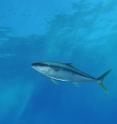As the oceans warm, wide-ranging species will have an edge
Related images
(click to enlarge)
Marine species that already have large ranges are extending their territories fastest in response to climate change, according to new research from University of British Columbia biodiversity experts. The study is one of the first comprehensive looks at how traits--other than thermal niche--impact marine animals' ability to respond to climate change. It could help improve global predictions of how different species redistribute as the oceans warm, and identify species in greatest jeopardy.
"We have a bit of a mystery as to why some animals are moving quickly into cooler waters, like the green sea urchin that is decimating kelp forests in Tasmania, while other species aren't moving at all," says UBC biodiversity researcher Jennifer Sunday, lead author of the study.
"Our findings indicate that animals which already have wide-latitudinal ranges, habitat generalists, and species with high adult mobility displayed the quickest and greatest range shifts. The flip side is that small-ranging species are in increased jeopardy as our planet's oceans continue to warm."
The researchers used a global marine hotspot, the fast-warming waters off Australia's east coast, as their lab. In Eastern Australia, the ocean has been warming four times faster than the global average--and many marine species have been appearing further south than ever before.
By factoring in species traits--along with predictions based on the warming pattern in the region--the researchers were able to more than double their ability to account for variation in range extensions.
The yellowtail kingfish, tiger shark, short-tail stingray and the Maori wrasse were some of the fish species with the largest range shifts in the region. Filter-feeding barnacles--omnivores that are notoriously invasive--also displayed some of the largest expansions of territory.
Meanwhile the spotted handfish, a coastal species in the same region, hasn't extended its distributional range into cooler waters despite shifting temperatures.
Source: University of British Columbia
Articles on the same topic
- Study sheds light on the ability of different marine species to respond to climate warmingMon, 20 Jul 2015, 20:34:46 UTC
- Marine travellers best able to adapt to warming watersMon, 20 Jul 2015, 16:08:15 UTC
Other sources
- As the oceans warm, wide-ranging species will have an edgefrom Science BlogMon, 20 Jul 2015, 16:00:12 UTC
- Marine travellers best able to adapt to warming watersfrom Science DailyMon, 20 Jul 2015, 15:00:35 UTC
- Marine Travellers Best Able to Adapt to Warming Watersfrom Newswise - ScinewsMon, 20 Jul 2015, 14:30:49 UTC
- Marine travellers best able to adapt to warming watersfrom PhysorgMon, 20 Jul 2015, 14:00:23 UTC

